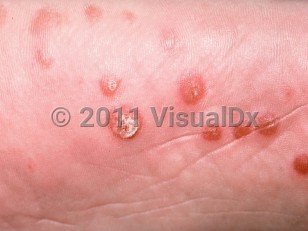Reactive arthritis in Child
See also in: Anogenital,Nail and Distal DigitAlerts and Notices
Important News & Links
Synopsis

Reactive arthritis (previously known as Reiter disease or Reiter syndrome) is a type of spondyloarthropathy that occurs after gastrointestinal or genitourinary infections. As in other spondyloarthropathies, reactive arthritis is associated with human leukocyte antigen (HLA)-B27.
Reactive arthritis was initially described after infections with specific bacteria: Chlamydia trachomatis, Shigella, Salmonella, Yersinia, and Campylobacter. Clostridioides difficile, Giardia, and other atypical infections have also been implicated as triggers for reactive arthritis. It is unclear how infections trigger the disease. In recent studies, Chlamydia has been isolated from the joint capsule in some cases.
It occurs most commonly in men ages 20-40. It can be especially common in patients with human immunodeficiency virus (HIV) infection and present with more severe symptoms. In children, the condition is rare. It is most commonly triggered by an enteric infection in young children and by a genitourinary infection in teenagers.
The hallmark features of reactive arthritis include urethritis, eye symptoms (conjunctivitis, iritis, uveitis), oral lesions, arthritis, and spinal involvement. Children often do not present with the full triad of conjunctivitis, urethritis, and arthritis. Conjunctivitis can precede other symptoms and signs. Asymmetric heel and knee pain due to joint and ligamentous inflammation is common in children. Additional symptoms include fever, malaise, anorexia, and weight loss.
For most patients, reactive arthritis is a self-limited disease, and they recover completely within 2-6 months. A chronic arthritis may persist in a minority, usually in association with HLA-B27 phenotype. Other patients can develop recurrent episodes of reactive arthritis after encountering the same organism.
Reactive arthritis was initially described after infections with specific bacteria: Chlamydia trachomatis, Shigella, Salmonella, Yersinia, and Campylobacter. Clostridioides difficile, Giardia, and other atypical infections have also been implicated as triggers for reactive arthritis. It is unclear how infections trigger the disease. In recent studies, Chlamydia has been isolated from the joint capsule in some cases.
It occurs most commonly in men ages 20-40. It can be especially common in patients with human immunodeficiency virus (HIV) infection and present with more severe symptoms. In children, the condition is rare. It is most commonly triggered by an enteric infection in young children and by a genitourinary infection in teenagers.
The hallmark features of reactive arthritis include urethritis, eye symptoms (conjunctivitis, iritis, uveitis), oral lesions, arthritis, and spinal involvement. Children often do not present with the full triad of conjunctivitis, urethritis, and arthritis. Conjunctivitis can precede other symptoms and signs. Asymmetric heel and knee pain due to joint and ligamentous inflammation is common in children. Additional symptoms include fever, malaise, anorexia, and weight loss.
For most patients, reactive arthritis is a self-limited disease, and they recover completely within 2-6 months. A chronic arthritis may persist in a minority, usually in association with HLA-B27 phenotype. Other patients can develop recurrent episodes of reactive arthritis after encountering the same organism.
Codes
ICD10CM:
M02.30 – Reiter's disease, unspecified site
SNOMEDCT:
67224007 – Reactive arthritis
M02.30 – Reiter's disease, unspecified site
SNOMEDCT:
67224007 – Reactive arthritis
Look For
Subscription Required
Diagnostic Pearls
Subscription Required
Differential Diagnosis & Pitfalls

To perform a comparison, select diagnoses from the classic differential
Subscription Required
Best Tests
Subscription Required
Management Pearls
Subscription Required
Therapy
Subscription Required
References
Subscription Required
Last Reviewed:10/01/2017
Last Updated:10/16/2022
Last Updated:10/16/2022
 Patient Information for Reactive arthritis in Child
Patient Information for Reactive arthritis in Child
Premium Feature
VisualDx Patient Handouts
Available in the Elite package
- Improve treatment compliance
- Reduce after-hours questions
- Increase patient engagement and satisfaction
- Written in clear, easy-to-understand language. No confusing jargon.
- Available in English and Spanish
- Print out or email directly to your patient
Upgrade Today

Reactive arthritis in Child
See also in: Anogenital,Nail and Distal Digit
